Comparison of Arguments on Banning Child Labor in Supply Chains
VerifiedAdded on 2022/11/30
|6
|1240
|211
Report
AI Summary
This report delves into the multifaceted issue of child labor, examining the arguments both for and against its ban, particularly within supply chains. The introduction defines child labor as the exploitation of underage children, setting the stage for a detailed analysis. The main body presents and compares various arguments, including the negative impact of child labor on education access, learning, and the rise of poverty. It also explores the consequences for future generations, and the legal, ethical, and practical challenges associated with banning child labor. The report concludes that arguments in favor of banning child labor are more compelling, highlighting the importance of government action to protect children and foster economic development. The report references several sources, including academic journals and books, to support its analysis and findings. The overall goal of the report is to provide a comprehensive understanding of the complexities surrounding child labor and its implications.
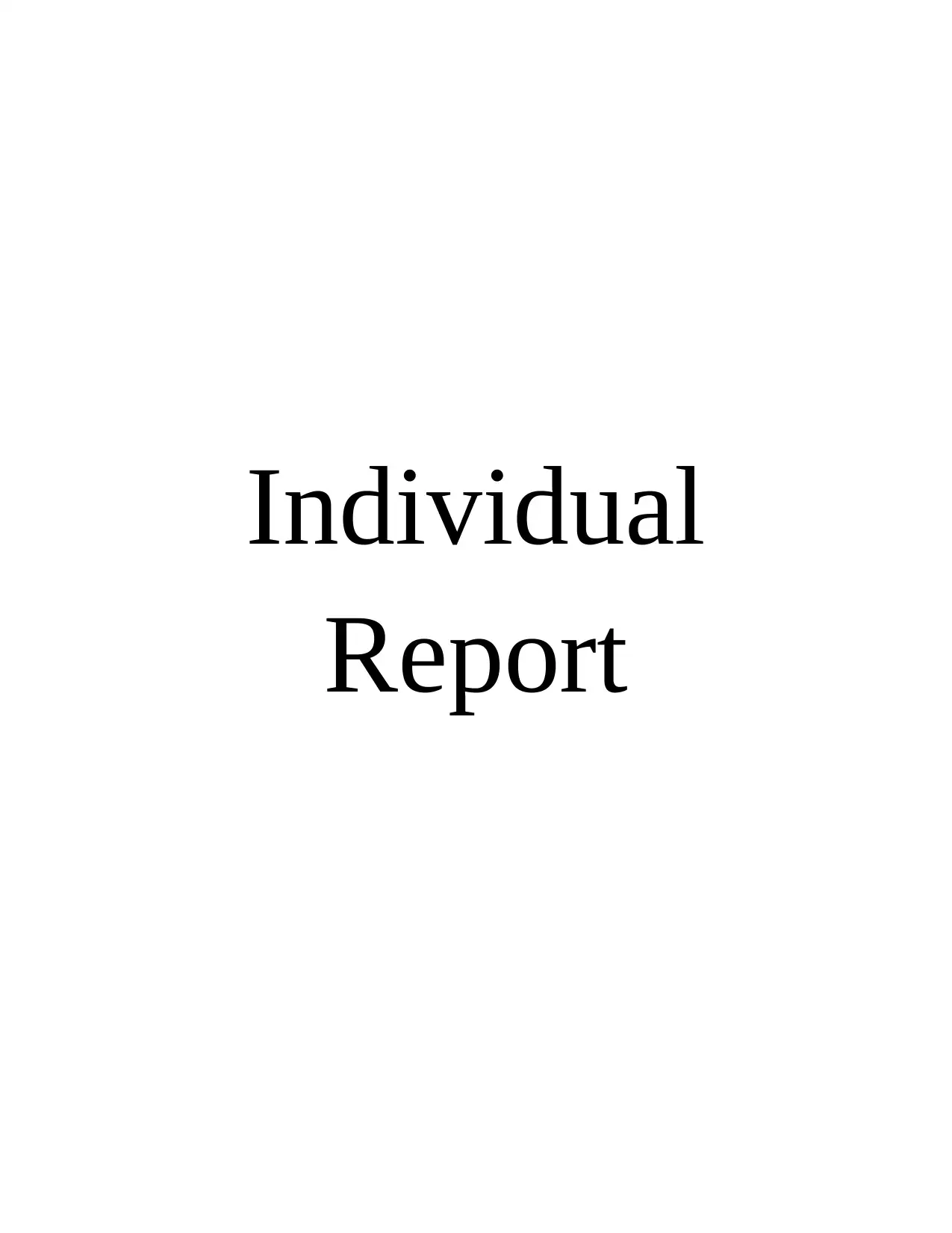
Individual
Report
Report
Paraphrase This Document
Need a fresh take? Get an instant paraphrase of this document with our AI Paraphraser

Contents
INTRODUCTION...........................................................................................................................................3
MAIN BODY.................................................................................................................................................3
CONCLUSION...............................................................................................................................................5
REFERENCES................................................................................................................................................6
INTRODUCTION...........................................................................................................................................3
MAIN BODY.................................................................................................................................................3
CONCLUSION...............................................................................................................................................5
REFERENCES................................................................................................................................................6
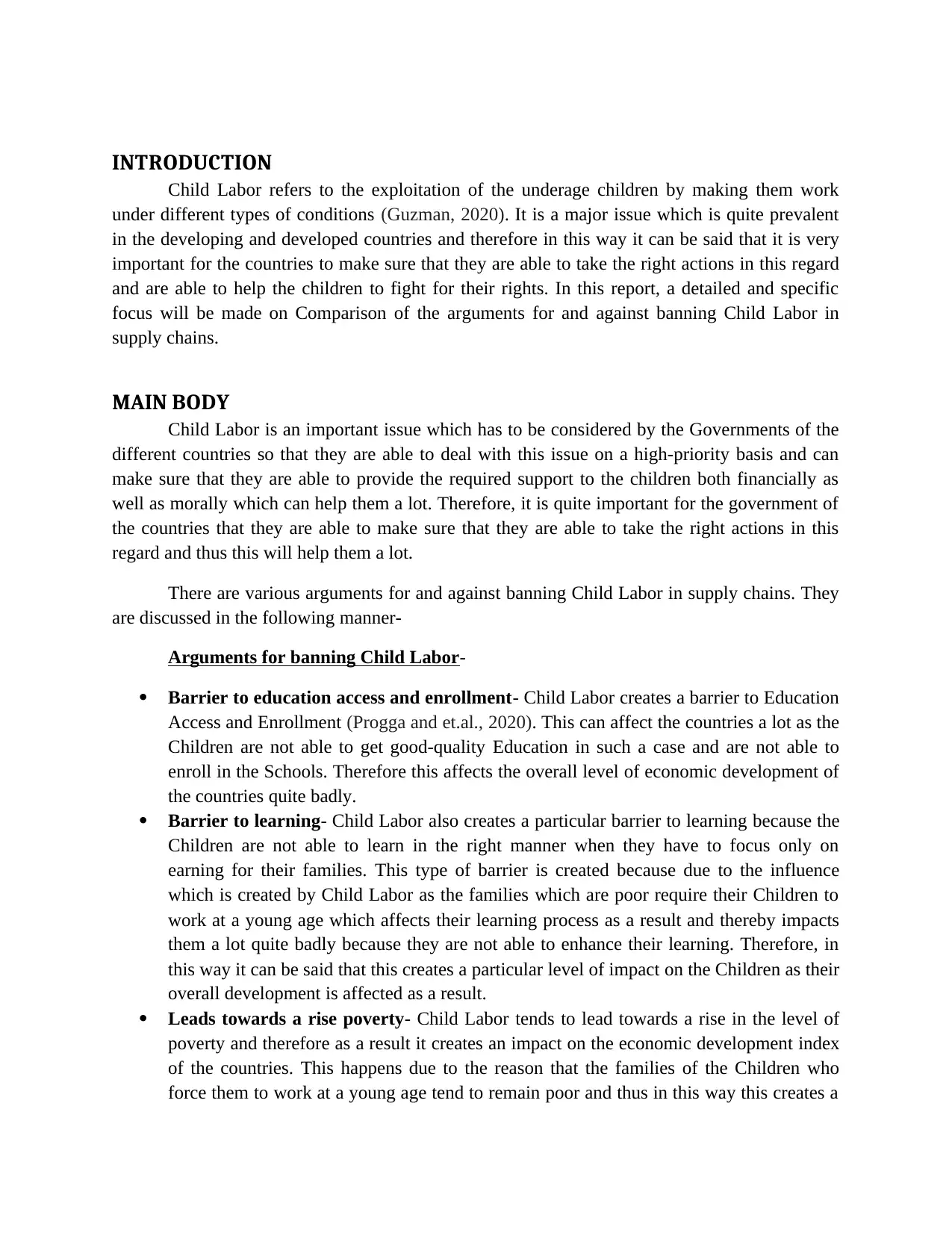
INTRODUCTION
Child Labor refers to the exploitation of the underage children by making them work
under different types of conditions (Guzman, 2020). It is a major issue which is quite prevalent
in the developing and developed countries and therefore in this way it can be said that it is very
important for the countries to make sure that they are able to take the right actions in this regard
and are able to help the children to fight for their rights. In this report, a detailed and specific
focus will be made on Comparison of the arguments for and against banning Child Labor in
supply chains.
MAIN BODY
Child Labor is an important issue which has to be considered by the Governments of the
different countries so that they are able to deal with this issue on a high-priority basis and can
make sure that they are able to provide the required support to the children both financially as
well as morally which can help them a lot. Therefore, it is quite important for the government of
the countries that they are able to make sure that they are able to take the right actions in this
regard and thus this will help them a lot.
There are various arguments for and against banning Child Labor in supply chains. They
are discussed in the following manner-
Arguments for banning Child Labor-
Barrier to education access and enrollment- Child Labor creates a barrier to Education
Access and Enrollment (Progga and et.al., 2020). This can affect the countries a lot as the
Children are not able to get good-quality Education in such a case and are not able to
enroll in the Schools. Therefore this affects the overall level of economic development of
the countries quite badly.
Barrier to learning- Child Labor also creates a particular barrier to learning because the
Children are not able to learn in the right manner when they have to focus only on
earning for their families. This type of barrier is created because due to the influence
which is created by Child Labor as the families which are poor require their Children to
work at a young age which affects their learning process as a result and thereby impacts
them a lot quite badly because they are not able to enhance their learning. Therefore, in
this way it can be said that this creates a particular level of impact on the Children as their
overall development is affected as a result.
Leads towards a rise poverty- Child Labor tends to lead towards a rise in the level of
poverty and therefore as a result it creates an impact on the economic development index
of the countries. This happens due to the reason that the families of the Children who
force them to work at a young age tend to remain poor and thus in this way this creates a
Child Labor refers to the exploitation of the underage children by making them work
under different types of conditions (Guzman, 2020). It is a major issue which is quite prevalent
in the developing and developed countries and therefore in this way it can be said that it is very
important for the countries to make sure that they are able to take the right actions in this regard
and are able to help the children to fight for their rights. In this report, a detailed and specific
focus will be made on Comparison of the arguments for and against banning Child Labor in
supply chains.
MAIN BODY
Child Labor is an important issue which has to be considered by the Governments of the
different countries so that they are able to deal with this issue on a high-priority basis and can
make sure that they are able to provide the required support to the children both financially as
well as morally which can help them a lot. Therefore, it is quite important for the government of
the countries that they are able to make sure that they are able to take the right actions in this
regard and thus this will help them a lot.
There are various arguments for and against banning Child Labor in supply chains. They
are discussed in the following manner-
Arguments for banning Child Labor-
Barrier to education access and enrollment- Child Labor creates a barrier to Education
Access and Enrollment (Progga and et.al., 2020). This can affect the countries a lot as the
Children are not able to get good-quality Education in such a case and are not able to
enroll in the Schools. Therefore this affects the overall level of economic development of
the countries quite badly.
Barrier to learning- Child Labor also creates a particular barrier to learning because the
Children are not able to learn in the right manner when they have to focus only on
earning for their families. This type of barrier is created because due to the influence
which is created by Child Labor as the families which are poor require their Children to
work at a young age which affects their learning process as a result and thereby impacts
them a lot quite badly because they are not able to enhance their learning. Therefore, in
this way it can be said that this creates a particular level of impact on the Children as their
overall development is affected as a result.
Leads towards a rise poverty- Child Labor tends to lead towards a rise in the level of
poverty and therefore as a result it creates an impact on the economic development index
of the countries. This happens due to the reason that the families of the Children who
force them to work at a young age tend to remain poor and thus in this way this creates a
⊘ This is a preview!⊘
Do you want full access?
Subscribe today to unlock all pages.

Trusted by 1+ million students worldwide
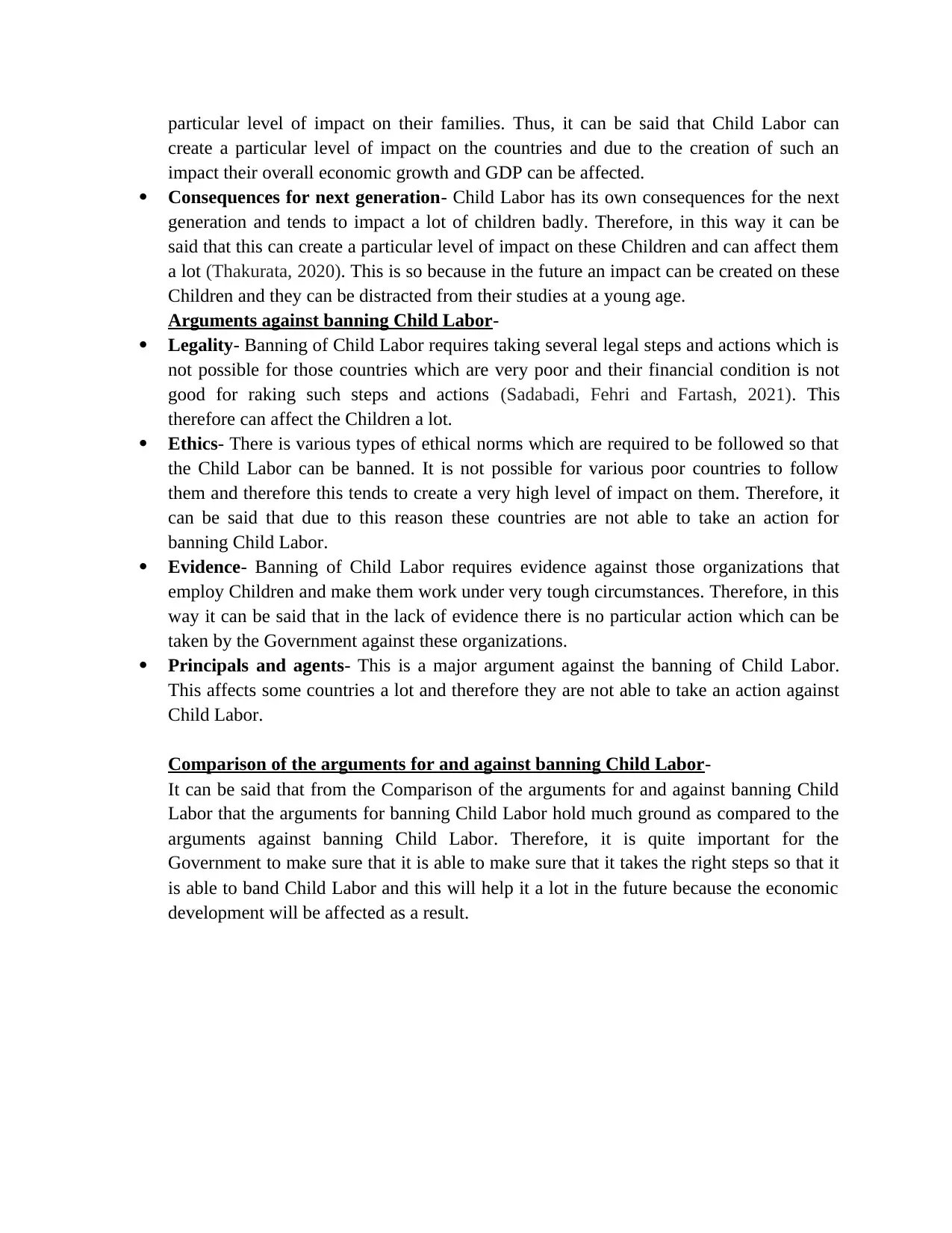
particular level of impact on their families. Thus, it can be said that Child Labor can
create a particular level of impact on the countries and due to the creation of such an
impact their overall economic growth and GDP can be affected.
Consequences for next generation- Child Labor has its own consequences for the next
generation and tends to impact a lot of children badly. Therefore, in this way it can be
said that this can create a particular level of impact on these Children and can affect them
a lot (Thakurata, 2020). This is so because in the future an impact can be created on these
Children and they can be distracted from their studies at a young age.
Arguments against banning Child Labor-
Legality- Banning of Child Labor requires taking several legal steps and actions which is
not possible for those countries which are very poor and their financial condition is not
good for raking such steps and actions (Sadabadi, Fehri and Fartash, 2021). This
therefore can affect the Children a lot.
Ethics- There is various types of ethical norms which are required to be followed so that
the Child Labor can be banned. It is not possible for various poor countries to follow
them and therefore this tends to create a very high level of impact on them. Therefore, it
can be said that due to this reason these countries are not able to take an action for
banning Child Labor.
Evidence- Banning of Child Labor requires evidence against those organizations that
employ Children and make them work under very tough circumstances. Therefore, in this
way it can be said that in the lack of evidence there is no particular action which can be
taken by the Government against these organizations.
Principals and agents- This is a major argument against the banning of Child Labor.
This affects some countries a lot and therefore they are not able to take an action against
Child Labor.
Comparison of the arguments for and against banning Child Labor-
It can be said that from the Comparison of the arguments for and against banning Child
Labor that the arguments for banning Child Labor hold much ground as compared to the
arguments against banning Child Labor. Therefore, it is quite important for the
Government to make sure that it is able to make sure that it takes the right steps so that it
is able to band Child Labor and this will help it a lot in the future because the economic
development will be affected as a result.
create a particular level of impact on the countries and due to the creation of such an
impact their overall economic growth and GDP can be affected.
Consequences for next generation- Child Labor has its own consequences for the next
generation and tends to impact a lot of children badly. Therefore, in this way it can be
said that this can create a particular level of impact on these Children and can affect them
a lot (Thakurata, 2020). This is so because in the future an impact can be created on these
Children and they can be distracted from their studies at a young age.
Arguments against banning Child Labor-
Legality- Banning of Child Labor requires taking several legal steps and actions which is
not possible for those countries which are very poor and their financial condition is not
good for raking such steps and actions (Sadabadi, Fehri and Fartash, 2021). This
therefore can affect the Children a lot.
Ethics- There is various types of ethical norms which are required to be followed so that
the Child Labor can be banned. It is not possible for various poor countries to follow
them and therefore this tends to create a very high level of impact on them. Therefore, it
can be said that due to this reason these countries are not able to take an action for
banning Child Labor.
Evidence- Banning of Child Labor requires evidence against those organizations that
employ Children and make them work under very tough circumstances. Therefore, in this
way it can be said that in the lack of evidence there is no particular action which can be
taken by the Government against these organizations.
Principals and agents- This is a major argument against the banning of Child Labor.
This affects some countries a lot and therefore they are not able to take an action against
Child Labor.
Comparison of the arguments for and against banning Child Labor-
It can be said that from the Comparison of the arguments for and against banning Child
Labor that the arguments for banning Child Labor hold much ground as compared to the
arguments against banning Child Labor. Therefore, it is quite important for the
Government to make sure that it is able to make sure that it takes the right steps so that it
is able to band Child Labor and this will help it a lot in the future because the economic
development will be affected as a result.
Paraphrase This Document
Need a fresh take? Get an instant paraphrase of this document with our AI Paraphraser
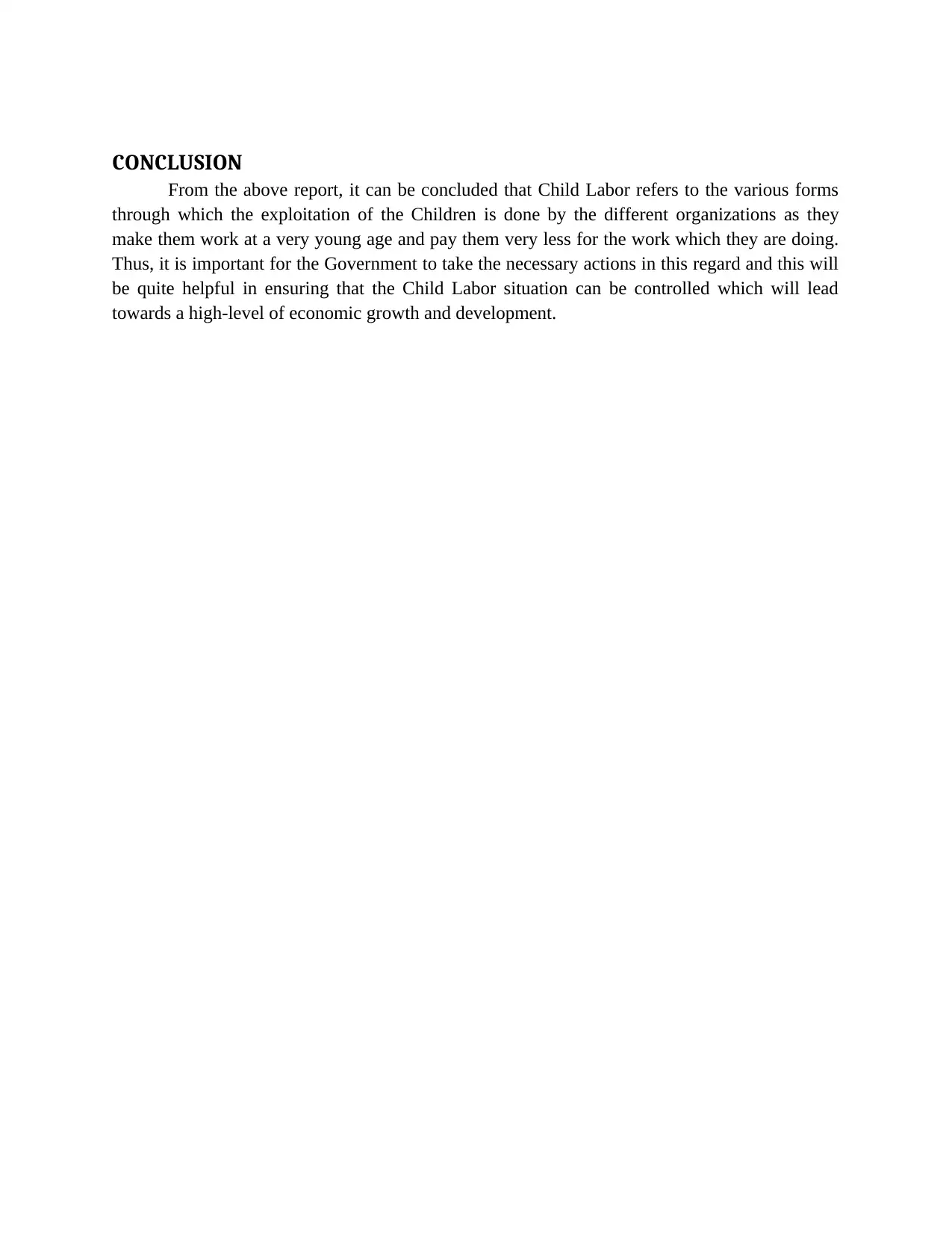
CONCLUSION
From the above report, it can be concluded that Child Labor refers to the various forms
through which the exploitation of the Children is done by the different organizations as they
make them work at a very young age and pay them very less for the work which they are doing.
Thus, it is important for the Government to take the necessary actions in this regard and this will
be quite helpful in ensuring that the Child Labor situation can be controlled which will lead
towards a high-level of economic growth and development.
From the above report, it can be concluded that Child Labor refers to the various forms
through which the exploitation of the Children is done by the different organizations as they
make them work at a very young age and pay them very less for the work which they are doing.
Thus, it is important for the Government to take the necessary actions in this regard and this will
be quite helpful in ensuring that the Child Labor situation can be controlled which will lead
towards a high-level of economic growth and development.
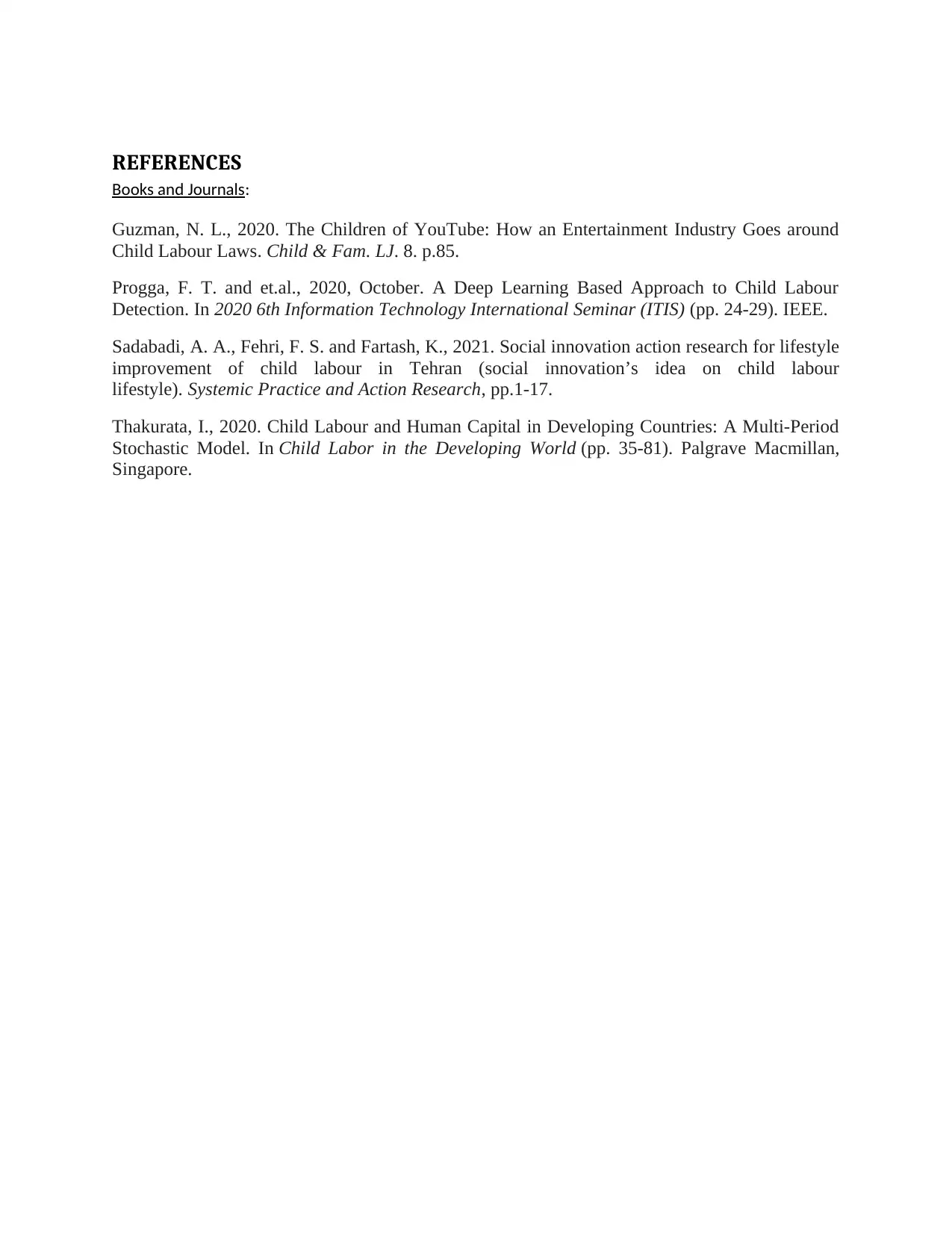
REFERENCES
Books and Journals:
Guzman, N. L., 2020. The Children of YouTube: How an Entertainment Industry Goes around
Child Labour Laws. Child & Fam. LJ. 8. p.85.
Progga, F. T. and et.al., 2020, October. A Deep Learning Based Approach to Child Labour
Detection. In 2020 6th Information Technology International Seminar (ITIS) (pp. 24-29). IEEE.
Sadabadi, A. A., Fehri, F. S. and Fartash, K., 2021. Social innovation action research for lifestyle
improvement of child labour in Tehran (social innovation’s idea on child labour
lifestyle). Systemic Practice and Action Research, pp.1-17.
Thakurata, I., 2020. Child Labour and Human Capital in Developing Countries: A Multi-Period
Stochastic Model. In Child Labor in the Developing World (pp. 35-81). Palgrave Macmillan,
Singapore.
Books and Journals:
Guzman, N. L., 2020. The Children of YouTube: How an Entertainment Industry Goes around
Child Labour Laws. Child & Fam. LJ. 8. p.85.
Progga, F. T. and et.al., 2020, October. A Deep Learning Based Approach to Child Labour
Detection. In 2020 6th Information Technology International Seminar (ITIS) (pp. 24-29). IEEE.
Sadabadi, A. A., Fehri, F. S. and Fartash, K., 2021. Social innovation action research for lifestyle
improvement of child labour in Tehran (social innovation’s idea on child labour
lifestyle). Systemic Practice and Action Research, pp.1-17.
Thakurata, I., 2020. Child Labour and Human Capital in Developing Countries: A Multi-Period
Stochastic Model. In Child Labor in the Developing World (pp. 35-81). Palgrave Macmillan,
Singapore.
⊘ This is a preview!⊘
Do you want full access?
Subscribe today to unlock all pages.

Trusted by 1+ million students worldwide
1 out of 6
Related Documents
Your All-in-One AI-Powered Toolkit for Academic Success.
+13062052269
info@desklib.com
Available 24*7 on WhatsApp / Email
![[object Object]](/_next/static/media/star-bottom.7253800d.svg)
Unlock your academic potential
Copyright © 2020–2025 A2Z Services. All Rights Reserved. Developed and managed by ZUCOL.





